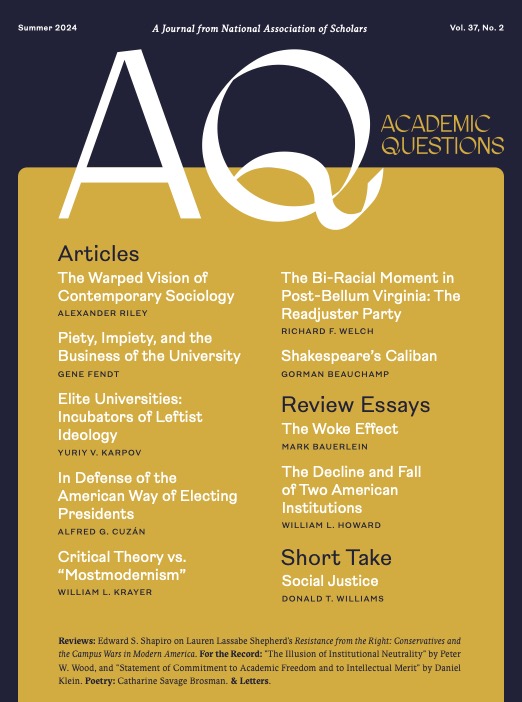The Origins of Woke: Civil Rights Law, Corporate America, and the Triumph of Identity Politics, Richard Hanania, Broadside Books, 2023, pp. 270, $29.00 hardcover.
America’s Cultural Revolution: How the Radical Left Conquered Everything, Christopher F. Rufo, Broadside Books, 2023, pp. 340, $19.00 hardcover.
In 1984, the U.S. Supreme Court issued Grove City College v. Bell, a decision that limited the power of the federal government to force private colleges and universities to meet Title IX requirements. Grove City did not take direct federal funding, and so it refused to submit to the government “assurance of compliance” reports showing that it did not engage in any discrimination by sex. Some Grove City students, however, did receive federal financial aid grants, which the government took as justification for monitoring the entire campus on Title IX grounds.
The grants were subsequently cancelled, prompting the students to join with Grove City in a lawsuit that finally reached the Supreme Court and ended in a 6-3 decision favoring the plaintiffs. Yes, the government could oversee Grove City, the Court reasoned, but only in those areas touched immediately by federal funding, in this case, the financial aid office. Sports, dorms, and everything else were free to operate without considering federal regulation. After the decision was announced, Grove City decided not to enroll any students on federal aid, leaving the school 100 percent liberated from D.C. officials.
The outcome may surprise many readers of Academic Questions, who know how heavy the weight of Title IX falls on colleges today. That’s because the episode didn’t end with the Supreme Court. In response to the decision, Congress passed the Civil Rights Restoration Act, which allowed exactly what the Supreme Court forbade. If a college gets federal funding aimed at any program or office, no matter how small the amount, the law said, the entire institution is subject to supervision, everything from bathrooms to athletics to job searches. President Reagan vetoed the bill at first, characterizing it as aggressive federal overreach. Almost every Democrat backed it, however, along with nearly half the Republicans in the House and two-thirds of them in the Senate, easily overriding Reagan’s opposition.
Richard Hanania tells the story of Grove City in The Origins of Woke, concluding, “One can hardly exaggerate the importance of the Civil Rights Restoration Act” (165). The Court’s judgment was a blow to liberal activists and campus leftists. Democrats moved quickly to undo it (the House passed a version of the bill the same year the decision came out), while a critical mass of Republicans crossed the aisle. The result emboldened identity politicians, Hanania says: “Title IX enforcement would not only go back to what it was but ramp up and become ever more intrusive, as the mainstream left became more radical in its ideas about gender and forced its views onto higher education” (165). If Republicans had stayed united—they did control the Senate—it wouldn’t have happened.
It’s just the kind of event that forms the actual “origins of woke,” Hanania argues, the many legal and institutional policy changes that laid the foundation for current public expressions of identity intolerance. Hanania includes the fact that these older developments didn’t get much publicity outside the Beltway. That was the era of the Culture Wars, which we remember more for The Closing of the American Mind and “Hey hey, ho ho, Western Culture’s got to go” than for verdicts and regulations that have a technical sound. Hanania’s book shifts the focus. He doesn’t mention Allan Bloom or Jesse Jackson. Instead, we hear about bureaucracy, human resources, lawsuits, legal tools such as disparate impact, and what Hanania calls “practical politics.” Race and gender are treated within the framework of the Federal government’s categorization of groups many decades ago through changes in the Census (90 ff.), not through the writings of Judith Butler and Robin D’Angelo. He gives to wokeness three pillars: one, “the belief that disparities equal discrimination”; two, speech restrictions; and three, “a full-time bureaucracy” that will “enforce correct thought and action” (4-5). From there, he continues, what is important is not the theoretical or historical basis for those pillars, but “specific government polities” (6) that uphold and enact them. The assumption is that it may be better to approach wokeness as law than as culture, at least at first, for the simple reason that in the space where wokeness has greatest effect on people’s lives—that is, jobs and money—an employer is guided by “the government regulations he lives under” (63), not by theories of whiteness and patriarchy. The ideas of Ibrahim Kendi are less illuminating than the explosion of the human resources industry, which had 140,000 workers in 1968, 1.5 million in 2021 (66-67). Another example: in 1992, only one percent of EEOC charges were for disability-based discrimination; in 2021, the rate rose to 37 percent (62).
This is the reform value of The Origins of Woke. If we wish to undo this insidious ideology, Hanania maintains, we can’t get caught up in controversial, viral-trending episodes such as the shrieking girl on the Yale quad and the Duke lacrosse case of nearly twenty years ago. The public’s reaction to those odious affairs certainly ran against identity politics, but they did nothing to slow the decent of campuses into DEI tyranny. The drama of scandal is but a diversion from the dry, legalistic machinations of the Office for Civil Rights in the U.S. Department of Education. How many conservatives know about Executive Order 10925, President Kennedy’s requirement that government contractors practice affirmative action regarding race, color, religion, or national origin (discussed by Hanania, 33ff.)? Or President Johnson’s addition of sex to the list of identities a few years later. LBJ’s Executive Order 11246 created what would become the Office of Federal Contract Compliance Programs (OFCCP), which, along with the EEOC, “are the most important institutions in the executive branch to reform or abolish,” Hanania says at the end of the book (205-06). In 2021, he adds, “the SEC approved new diversity requirements for corporate boards listed on Nasdaq’s U.S. exchange.” And yet, that imposition “attracted relatively little attention.”
This means that wokeness will continue unless a particular group rises against it: Republicans in office. If woke practices are embedded in and authorized by government routines hidden from the public eye, only officials within the government can stop them. It’s a frustrating situation for informed conservatives, who’ve watched victorious Republicans become do-nothings time and again (relative to identity matters) ever since Reagan left office. But we have no other champions, no one else rightly positioned. The left understood the value of bureaucratic capture from the beginning. Better ideas accomplish nothing if they have no platform. Hanania’s book is a tutelage for Republicans who win next November. We shall see if they’ve learned.
Still, once we identify the consequences of a small revision to a federal regulation or, say, the machinations of Russlyn Ali, the author of Dear Colleague letters issued to colleges during the Obama term, an intellectual history of ideas and theories that prepared for that revision and those letters can only help. It is important to know the exact language of executive orders and legislation, along with what it wrought. It is also important to uncover the concepts that produced that language. Where did the idea of microaggressions come from? How did a notion as unpopular as “white fragility” get traction?
Answering such questions is the purpose of Christopher Rufo’s recent book, which charts the sweeping identity transformation of our country from the 1960s to the present. Rufo calls the book an “inner history of America’s cultural revolution. It is a genealogy of darkness” (xi), a survey of “the historical development of the modern Left and its ideological foundations” (x). To compile it, Rufo examined not government bureaucracy (as Hanania did), but “hundreds of books, papers, studies, and newspaper articles.” The ideas of Paolo Freire (“Master of Subversion”) are covered, those of Derrick Bell (“Prophet of Racial Pessimism”), Eldridge Cleaver, and the Weathermen, too. If you wish to stop the revolution, you must know its gurus. That’s the premise. Those who are alarmed at the cancellation of people who espouse social conservative beliefs such as a Biblical conception of marriage, Rufo says, should read Herbert Marcuse’s infamous essay on “repressive tolerance.” The noxious conclusion of it is a fitting climax of the Sixties:
Withdrawal of tolerance from regressive movements before they can become active; intolerance even toward thought, opinion, and word, and finally, intolerance in the opposite direction, that is, toward the self-styled conservatives, to the political Right.
That battle plan fits perfectly today’s social justice warriors marching on the president’s office, calling for conservative professors to be fired, and logging into bias reporting systems with glee. Rufo quotes Marcuse on the next step in the plan, which we saw neatly illustrated in summer 2020 with eruptions of violence in more than 200 cities and the rationalization of that tumult by journalists and intellectuals.
I believe that there is a “natural right” of resistance for oppressed and overpowered minorities to use extralegal means if the legal ones have proved to be inadequate. If they use violence, they do not start a new chain of violence, but try to break an established one.” (23)
It is tempting, of course, for conservatives to denounce Marcuse and move on. But this is to ignore why the essay proved so electrifying to the radical left (and the sympathizing center-left). In truth, the thirty-page road to that illiberal pronouncement is a rhetorical tour de force, a polemic of deep learning and political savvy. Rufo nicely lays out the battle plan in Marcuse’s essay and in other writings such as An Essay on Liberation. They explain why objecting to cancellation on solid First Amendment grounds, or appealing to Millian liberalism and its appreciation of dissent, is to say nothing that impresses the “cancellers.”
The axioms of repressive tolerance are untouched by ideals of free speech and intellectual diversity. What do those high-sounding terms mean when, Rufo writes (paraphrasing Marcuse), “modern capitalist democracies have produced the superficial appearance of peace, but in truth, they have simply masked and legitimized their own war of repression against the people” (23). The marketplace of ideas, the level playing field, the Ivory Tower—they don’t exist. They’re liberal fantasies, ideological smokescreens that obscure the oppressive politics always already in play. Marcuse and his many followers, including Angela Davis (whom Rufo profiles at length), believe they’ve exposed the vicious truth, power unveiled, and they regard individuals but one inch to the right of them on these matters as reactionaries and tools of the powerful.
If you debate an identity politician and don’t expect such accusations to come up, you’re fighting with inferior weaponry. I’ve witnessed too many occasions when leftists debated liberals and conservatives both, and the former trounced the latter through their bare moral fervor. There is an intellectual genesis to the outrageous contentions and rationalizations leftists make, often unknown to centrists and rightists, and it puts them at a disadvantage. Rufo’s intellectual history unearths the ideas and tracks how they made their way into institutions. Again, it is not enough to declare Marcuse wrong-wrong-wrong. We must know how and why he became “Father of the Revolution” (that’s the epigraph to Chapter 1).
No common institutional practice at the current time is more revolutionary than DEI. It has become a heated topic in the last two years, much of the publicity owing to Rufo himself, who has positioned himself as a clearinghouse for whistleblower materials lifted from orientation sessions, curriculum documents, hiring strategies, etc. Here’s a surprise to be found in America’s Cultural Revolution: one of the most influential founders of DEI exercises is . . . Marcuse’s third wife, forty years his junior, at one time his teaching assistant, Erica Sherover-Marcuse. We might say that she devised an ingenious way to put her husband’s intolerant tactic into practice, though under a professional cover.
After the revolutionary destructions of the Sixties wore out, Rufo says, Sherover-Marcuse took a different route, infiltrating the very institutions the radicals loathed with seemingly benign moral tools, that is, workshops on institutionalized racism, internalized oppression, and the like. She created the “privilege walk,” an exercise that arranges students in an “oppression hierarchy” with whites ahead of blacks, upper income ahead of lower income, nuclear family before non-nuclear, and straight before LGBT, then asks the forward ones to be ashamed of their advantages. My niece underwent the exercise in her upscale Orange County high school some years ago.
Sherover-Marcuse’s genius was to take the consciousness raising movement of the Seventies and turn it to identity-politics goals. The New Left failed to triumph in America—Nixon’s resounding win in 1972 proved that—precisely because it had failed to “transform people’s consciousness,” she said (46). Marxism lacked a proper “theory of the development of subjectivity.” Too many Americans suffer from “unaware racism, unaware sexism, and unintentional classism,” so we can’t reform them unless we get inside their heads. Hence the antiracism seminar leader who presumes to observe biases that the attendees exert without consciousness of them, and the Stanford DEI dean who presumes to berate a federal judge for his insensitivity. Sherover-Marcuse gave them this confidence. According to Rufo, she “developed the entire theoretical and linguistic framework for the DEI industry writ large” (47).
There are other illuminating vignettes. The story Rufo tells reveals how focused and relentless was the march of the left through the institutions. Lots of people, many of them smart and canny, dedicated their lives to the revolution. It was a career, a cause, a religion, a war, and they fought well.
Nevertheless, Rufo remains upbeat. He asserts in the Preface that his book is “a work of determined optimism” (xi), and the successes he has scored in the last two years in helping oust CRT from public schools and DEI from state governments vindicate the attitude. The revolution has, indeed, transformed American life, but it’s not as secure as it seems, nor is it as popular once we exit elite zones. Rufo claims that the revolution has its roots not in the hope of a better society, as wokesters insist, but rather in bitter nihilism. Woke is a punitive, humorless posture. It wants to destroy, not build, as the dozens of endorsements from the Sixties and Seventies of revolutionary violence cited in America’s Cultural Revolution demonstrate. The revolution “can be overcome,” Rufo says in the last paragraph of the book, because the promises of the hard left haven’t materialized, notwithstanding its conquest of one institution after another in the last half-century. On the contrary, those promises “always vanish into the ether” (282). The left doesn’t deserve the confidence it has. Rufo’s book should give the right an equal confidence. It urges conservatives to see through the veil of diversity and inclusion and spot the radical aims in play. No longer will they accept movements such as Black Lives Matter as a worthy moral renovation. It’s a revolution, not a reform, and it must be recognized in all its controlling, pernicious nature.
Mark Bauerlein is professor emeritus of English at Emory University, Atlanta, GA 30322; [email protected]. His latest books are The Dumbest Generation Grows Up: From Stupefied Youth to Dangerous Adults (Regnery, 2022); The State of the American Mind: 16 Leading Critics on the New Anti-Intellectualism, co-edited with Adam Bellow (Templeton, 2015); and The Digital Divide: Arguments for and Against Facebook, Google, Texting, and the Age of Social Networking (Jeremy P. Tarcher, 2011). Bauerlein last appeared in these pages with his article “Netflix Whiffs on the Humanities,” in the summer of 2021.














